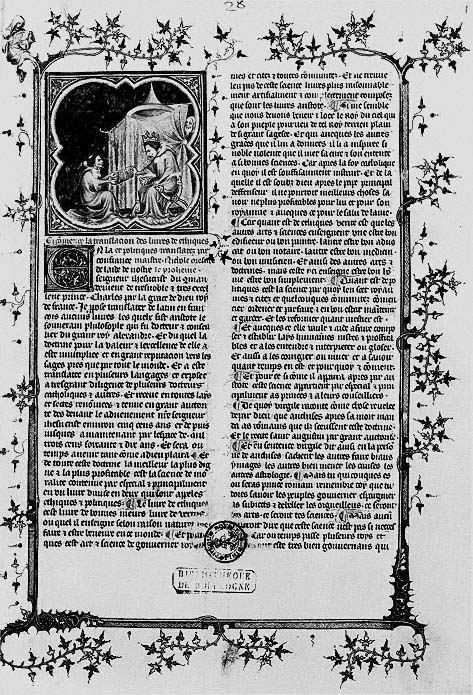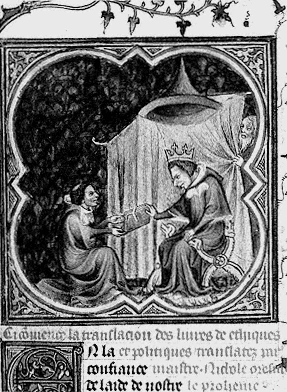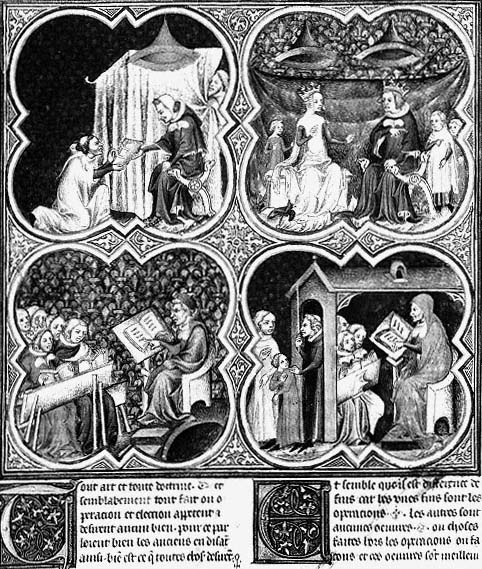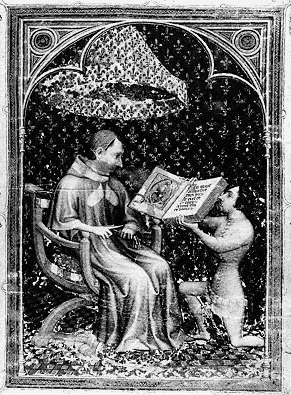The Dedication Portrait and Frontispiece of the Prologue in MS A
A comparison of the dedication scene of C with those of A reveals a different approach to illustration. All three, however, belong to the intimate type of dedication portraits, marked by the direct communication of the king with authors or translators, without the intervention of courtiers or officials.[1] The intimate dedication portrait confirms the king's intellectual character and his enjoyment of the company of the writers and translators in his entourage. The close relationship between Charles and Oresme, for example, is documented in the dedication scene of Oresme's translation of Ptolemy's Quadripartitum (Fig. 3), dating from 1361 or 1362.[2]
As the first miniature in the manuscript (Figs. 6 and 6a), the dedication scene of the prologue exemplifies the usual format of the A illustrations. The miniature is tied to the design of the folio both in its width, equal to that of a column, and in its height, equal to sixteen lines of text. Links to the decorative structure of the folio are also strong. Figure 6 receives emphasis by its relationship to the initial E , the outer frame, and the foliate border. The inner frame of Figure 6, a red, white, and blue quadrilobe, is a typical feature of this manuscript and many others of the period. Also standard for the illuminations of this cycle is the simple double outer frame and the gold lozenges that fill out the area between the outer rectangle and the quadrilobe. The rose fleur-de-lis background is used in the first six miniatures of the A cycle. Although it plays a decorative role, it also alludes to the patron's royal status—here explicitly, elsewhere implicitly. Figure 6, moreover, follows the major color scheme of the cycle, based on a red-gold-blue triad. Charles V, wearing a blue mantle trimmed with white fur, stands out against the gold curtain and the rose fleur-de-lis outlined in black. Oresme's costume, a more subdued blue-gray, falls into the same color range. Red accents are found in the baldachin, the book, and the bystander's mantle. Gold is more prominent than usual, used here not only in the curtain but also in the faldstool and crown.
The baldachin and fleur-de-lis motifs of Figure 6, repeated in the dedication scene of Figure 7, are indebted to the famous presentation scene by Jean Bondol representing Charles V and Jean de Vaudetar, the donor of the book, a Bible historiale , dated 1371 (Fig. 8).[3] The style of Figure 7 is also closer to that of the Bondol prototype. The convincing gestures and expressions of the king and translator suggest that this dedication scene, part of the elaborate frontispiece, was executed

Figure 6
Charles V Receives the Book from Nicole Oresme. Les éthiques d'Aristote, MS A.

Figure 6A
Detail of Fig. 6.
by the head master of the Jean de Sy shop. The excessively large head and truncated body of Charles V in the prologue dedication (Fig. 6), in contrast, suggest that a member of this atelier was entrusted with this more modest miniature. Whereas the image of the king in Figure 6 is more conventional and his appearance more youthful than in Figure 7, the portraits of Oresme are both individualized. Also similar in both dedications is the gold curtain, suspended from rods and set obliquely to the picture space; its boxlike character defines the royal sphere. Although its abbreviated form permits no conclusions, it suggests an enclosed chamber or other private space as the locale of the presentation.[4]
The documentary function of Figure 6 is related to its position at the head of the first column of text on folio 1 of the manuscript. The illustration identifies those who set in motion the translation contained in the volume presented. Kneeling at the left is the translator, whose name appears in the three-line rubric written under the miniature: "Ci commence la translacion des Livres de Ethiques et Politiques translatéz par maistre Nichole Oresme" (Here begins the translation of the books

Figure 7
Above, from left: Charles V Receives the Translation from Nicole Oresme, Charles V and
His Family; below, from left: A King and His Counsellors Attend a Lecture, The Expulsion
of a Youth from a Lecture. Les éthiques d'Aristote, MS A.

Figure 8
Jean Bondol, Charles V Receives the Book from
Jean de Vaudetar. Bible historiale.
of the Ethics and Politics translated by Master Nicole Oresme).[5] The next sentence, highlighted by an elaborate six-line foliated and dentellated initial E names the patron:
En la confiance de l'aide de Nostre Seigneur Jhesu Crist, du commandement de tres noble et tres excellent prince Charles, par la grace de Dieu roy de France, je propose translater de latin en françois aucuns livres lesquelx fist Aristote le souverain philosophe, qui fu docteur et conseillier du grant roy Alexandre.
(Confident of the help of Our Lord Jesus Christ, at the command of the most noble and most excellent Prince Charles, by the grace of God, king of France, I propose to translate from Latin into French some books written by Aristotle, the supreme philosopher, who was the teacher and counsellor of the great king Alexander.)[6]
The crown and faldstool associated with the king seated on the right establish the royal identity of Charles V. Two other features of this introductory sentence are worthy of comment. First, Oresme gives himself an important role in the enterprise by using the phrase "je propose." Then he sets up a discreet but flattering parallel between Charles V and himself, the contemporary equivalents of Alexander and Aristotle, in their roles as ruler and counsellor, pupil and teacher. Following a medieval custom, the translator's appropriation of Aristotle's identity as author carries out this theme on a visual level.
Oresme also points to the value of the text, recognized by "pluseurs docteurs catholiques et autres" (many Catholic doctors [of the Church] and other authorities), and its universal reputation "en toutes lays et sectes" (in all religions and sects), from the time of its composition to the present day.[7] The translator does not neglect to pay tribute to the wisdom and intellectual interests of his patron.[8] Charles V's love of study and learning not only promotes the common good but unites the two men. These mutual interests and long personal ties are commemorated in Figure 6a, particularly in the direct glances and friendly expressions of both parties. While Oresme's kneeling posture expresses his respect, his knee and hands penetrate the space occupied by the king. Moreover, the left side of the book held by Oresme is supported on the right by Charles V. The volume's red color, highlighted against the gold curtain, emphasizes the book as both document and symbol of the concrete tie that exists because of their mutual efforts. Finally, the gesture of Oresme's left hand indicates the act of handing the book over to the king, a moment of gratification to both translator and patron.